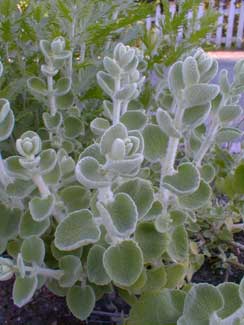
Grecian Horehound;
or, False Dittany
"Excellent herbs had our fathers of old --
Excellent herbs to ease their pain --
Alexanders & Marigold,
Eyebright, Orris, & Elecampane --
Basil, Rocket, Valerian, Rue,
(Almost singing themselves they run)
Vervain, Dittany, Call-me-to-you --
Cowslip, Melilot, Rose of the Sun.
Anything green that grew out of the mould
Was an excellent herb to our fathers of old."
-Rudyard Kipling
(865-1936)
(865-1936)
Ballota pseudodictamnus (formerly Marrubium pseudodictamnus) is a mint-family herb known as Grecian Horehound or False Dittiny. We already had a single clump of B. pseudodictamnus 'Nana,' or Dwarf Grecian Horehound, when we added the full-sized species to another property-edge garden that gets full sun & very little water.
The species has leaves twice the size of the dwarf. In full sun it grows to a foot & a half or two feet in height, & at least as wide, a rounded & compact herb. Its ideal soil is light & slightly alkaline, though it has done fine in our naturally acidic soils.
Native to Greece, Crete, Turkey & Libya, it adapts to more notherly climates so long as it never has wet feet & is given the sunniest possible location. It is evergreen here in the Pacific Northwest (Zone 8) & rarely suffers any winter damage, being hardy to ten degrees Fahrenheit.
It requires a xeriscape garden & would not like a wet location. If it ever seems stressed in the rainy seasons, it might be of benefit to place flat rocks around the plant so that it feels like it is growing up between rocks as it would in the wild. Ours has not needed even that much attention, quickly draining soil being sufficient to see it through our wet autumns & winters.
It is often recommended to cut it back once a year, in late winter/early spring, to let it start afresh. But as a subshrub it often looks just fine two years running without pruning, & its central stems will become woodier the second year. But after a couple of years, an unpruned specimen gets leggy or otherwise loses its compact perfection. Eventually it will need a winter's end hard prune or alternatively a post-flowering sheering.
Small flowers in early summer are pink, or white with purple; they are pleasing enough, but not as significant ornamentally as the wooly leaves themselves.